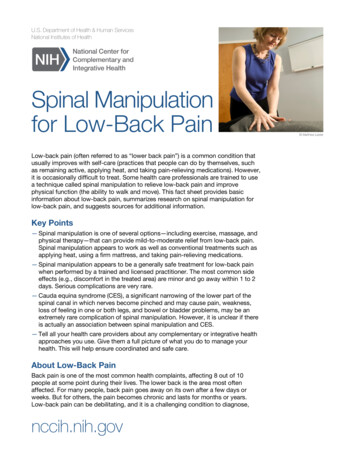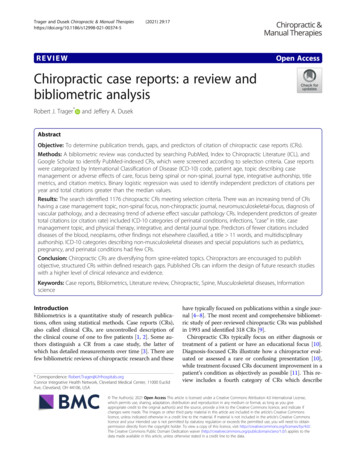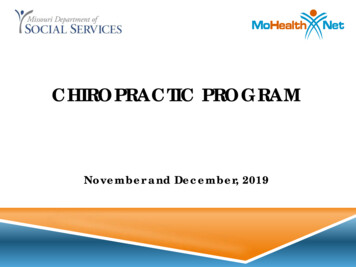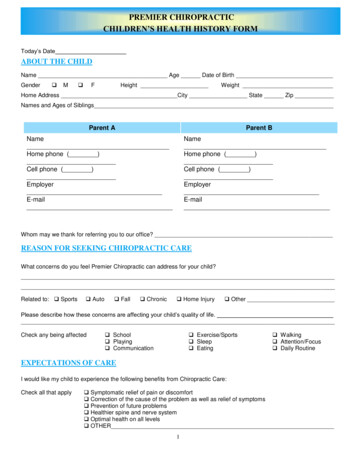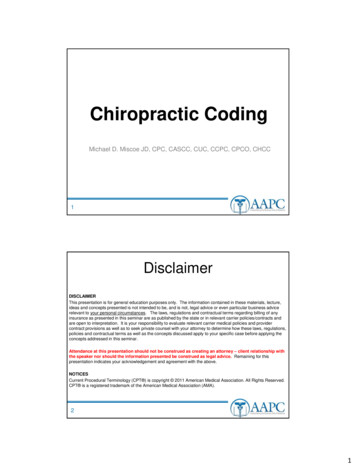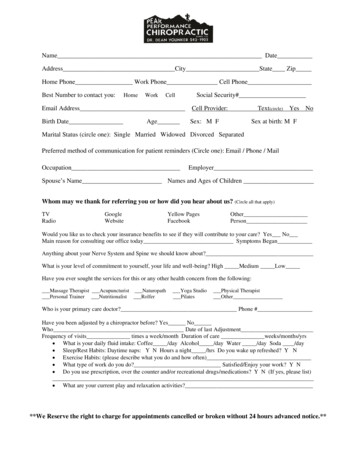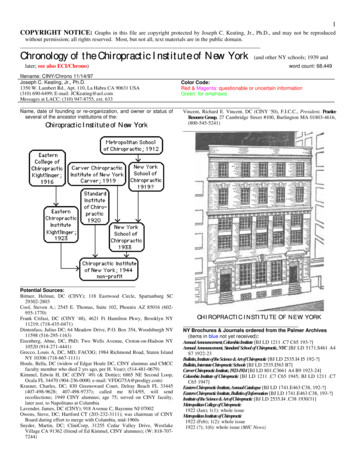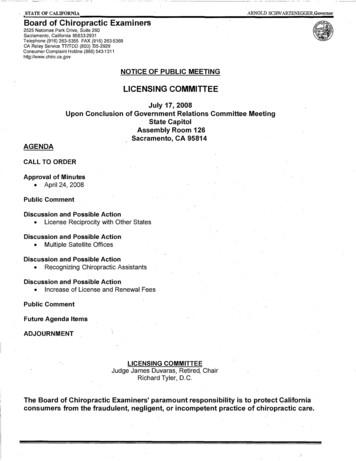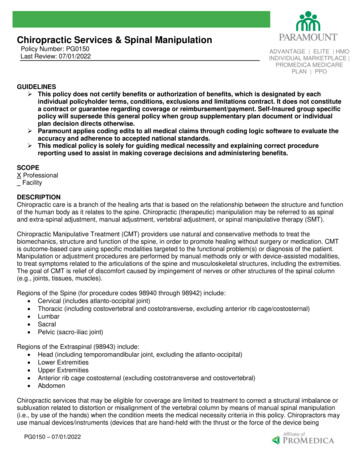
Transcription
Chiropractic Services & Spinal ManipulationPolicy Number: PG0150Last Review: 07/01/2022ADVANTAGE ELITE HMOINDIVIDUAL MARKETPLACE PROMEDICA MEDICAREPLAN PPOGUIDELINES This policy does not certify benefits or authorization of benefits, which is designated by eachindividual policyholder terms, conditions, exclusions and limitations contract. It does not constitutea contract or guarantee regarding coverage or reimbursement/payment. Self-Insured group specificpolicy will supersede this general policy when group supplementary plan document or individualplan decision directs otherwise. Paramount applies coding edits to all medical claims through coding logic software to evaluate theaccuracy and adherence to accepted national standards. This medical policy is solely for guiding medical necessity and explaining correct procedurereporting used to assist in making coverage decisions and administering benefits.SCOPEX ProfessionalFacilityDESCRIPTIONChiropractic care is a branch of the healing arts that is based on the relationship between the structure and functionof the human body as it relates to the spine. Chiropractic (therapeutic) manipulation may be referred to as spinaland extra-spinal adjustment, manual adjustment, vertebral adjustment, or spinal manipulative therapy (SMT).Chiropractic Manipulative Treatment (CMT) providers use natural and conservative methods to treat thebiomechanics, structure and function of the spine, in order to promote healing without surgery or medication. CMTis outcome-based care using specific modalities targeted to the functional problem(s) or diagnosis of the patient.Manipulation or adjustment procedures are performed by manual methods only or with device-assisted modalities,to treat symptoms related to the articulations of the spine and musculoskeletal structures, including the extremities.The goal of CMT is relief of discomfort caused by impingement of nerves or other structures of the spinal column(e.g., joints, tissues, muscles).Regions of the Spine (for procedure codes 98940 through 98942) include: Cervical (includes atlanto-occipital joint) Thoracic (including costovertebral and costotransverse, excluding anterior rib cage/costosternal) Lumbar Sacral Pelvic (sacro-iliac joint)Regions of the Extraspinal (98943) include: Head (including temporomandibular joint, excluding the atlanto-occipital) Lower Extremities Upper Extremities Anterior rib cage costosternal (excluding costotransverse and costovertebral) AbdomenChiropractic services that may be eligible for coverage are limited to treatment to correct a structural imbalance orsubluxation related to distortion or misalignment of the vertebral column by means of manual spinal manipulation(i.e., by use of the hands) when the condition meets the medical necessity criteria in this policy. Chiropractors mayuse manual devices/instruments (devices that are hand-held with the thrust or the force of the device beingPG0150 – 07/01/2022
controlled manually) in performing manual manipulation of the spine and related muscles/tissues.POLICYHMO, PPO, Individual Marketplace, Advantage Chiropractic services & spinal manipulation do not require prior authorization for adultsand children 4 years of age and older. Chiropractic services & spinal manipulation (98940-98943) require prior authorization forchildren under 4 years of age.Elite/ProMedica Medicare Plan Effective 1/1/2021 a Prior Authorization is required for all chiropractic visits exceeding 30per year. This policy includes all combination of procedure codes 98940, 98941 and 98942.Advantage, Elite/ProMedica Medicare Plan The allowed visits in the outpatient setting is thirty dates of service per benefit year for anmember younger than twenty-one years of age, fifteen dates of service per benefit year fora member twenty-one years of age or older. These limits may be exceeded with priorauthorization. Procedure 98943 is non-covered for Elite/ProMedica Medicare Plan & Advantage.Additional medical policies to reference: Refer to PG0036 Vertebral Axial Decompression Therapy for coverage determination forprocedures 97012 and S9090. Refer to PG0158 Physical Therapy (PT) and Occupational Therapy (OT) for coveragedetermination.COVERAGE CRITERIAParamount will cover medically necessary chiropractic services, if covered as outlined in the member’ssummary of benefits. Copayments, deductibles and/or coinsurance will apply pursuant to the terms of themember’s benefit plan document. Note: some plans have limitations or exclusions applicable to chiropractic care,therefore the members benefit language should be reviewed before applying the coverage criteria terms of thismedical policy.Coverage is limited to medically necessary services provided by a licensed doctor of chiropractic, within the scopeof their license.HMO, PPO, Individual MarketplaceChiropractic services & spinal manipulation (98940-98943) require prior authorization for children under 4 years ofage. (See below for ICD-10 codes for under 4 years of age.)Coverage of chiropractic services is limited to manual manipulation (by use of the hands) of the spine for correctinga subluxation for acute or chronic active/corrective treatment. Subluxation is defined as a motion segment in which alignment, movement integrity and/or physiologicalfunction of the spine are altered although contact between joint surfaces remains intact. Chiropractors may use manual devices (those that are hand-held with the thrust of the force of the devicebeing controlled manually) in performing manual manipulation of the spine.Paramount considers chiropractic services medically necessary when all of the following coverage criteria is met: The member has a neuromusculoskeletal disorder that may be improved or resolved by standardchiropractic therapy; and The medical necessity for treatment is clearly documented (including symptoms/diagnosis being treated,diagnostic procedures and treatment modalities used, results of diagnostic procedures, treatments,PG0150 – 07/01/2022
anticipated length of treatments and quantifiable, attainable treatment goals); andThe chiropractic care must be necessary for and appropriate to the diagnosis, treatment, cure, or relief of aneuromusculoskeletal condition, illness, injury, disease or its symptoms; andImprovement is documented within the initial 2 weeks of chiropractic care; andChiropractic care is performed within the scope of the license of a chiropractor. If no improvement is documented within the initial 2 weeks, additional chiropractic treatment is considerednot medically necessary unless the chiropractic treatment is modified. If no improvement is documented within 30 days despite modification of chiropractic treatment, continuedchiropractic treatment is considered not medically necessary. Once the maximum therapeutic benefit has been achieved, continuing chiropractic care is considered notmedically necessary.Non-Covered: Services rendered by non-participating chiropractors, Services in excess of benefit or visit limits, Chiropractic manipulation in asymptomatic members without an identifiable clinical condition, If therapeutic benefit has reached a plateau, Chiropractic services for maintenance programs or supportive care, If the patient’s condition becomes worse or regresses, If the therapeutic goals have been reached, If the patient has become asymptomatic, If the patient or parent/caregiver can independently practice or self-administer the activities or servicessafely and effectively If the services or activities are for the general good or welfare of the patient, such as exercise to promoteoverall fitness, flexibility, endurance, aerobic conditioning, maintenance of range of motion or strength, andweight reduction.Chiropractic manipulation and adjunct therapeutic procedures/modalities (e.g., mobilization, therapeutic exercise,traction) for treatment of non-musculoskeletal conditions are considered experimental, investigational or unproven.Elite/ProMedica Medicare PlanIndications: (CMS Publication 100-02, Medicare Benefit Policy Manual, Chapter 15, Section 240.1.3).The patient must have a significant health problem in the form of a neuromusculoskeletal condition necessitatingtreatment, and the manipulative services rendered must have a direct therapeutic relationship to the patient’scondition and provide reasonable expectation of recovery or improvement of function.The patient must have a subluxation of the spine as demonstrated by x-ray or physical exam. The primarydiagnosis must be subluxationMost spinal joint problems fall into the following categories: Acute subluxation - A patient’s condition is considered acute when the patient is being treated for a newinjury, identified by x-ray or physical exam as specified above. The result of chiropractic manipulation isexpected to be an improvement in, or arrest of progression, of the patient’s condition. Chronic subluxation - A patient’s condition is considered chronic when it is not expected to significantlyimprove or be resolved with further treatment (as is the case with an acute condition), but where thecontinued therapy can be expected to result in some functional improvement. Once the clinical status hasremained stable for a given condition, without expectation of additional objective clinical improvements,further manipulative treatment is considered maintenance therapy and is not covered. An acute exacerbation is a temporary but marked deterioration of the patient’s condition that is causingsignificant interference with activities of daily living due to an acute flare-up of the previously treatedcondition. The patient’s clinical record must specify the date of occurrence, nature of the onset, or otherPG0150 – 07/01/2022
pertinent factors that would support the medical necessity of treatment. As with an acute injury, treatmentshould result in improvement or arrest of the deterioration within a reasonable period of time.Maintenance TherapyMaintenance therapy includes services that seek to prevent disease, promote health and prolong and enhance thequality of life, or maintain or prevent deterioration of a chronic condition. When further clinical improvement cannotreasonably be expected from continuous ongoing care, and the chiropractic treatment becomes supportive ratherthan corrective in nature, the treatment is then considered maintenance therapy.ContraindicationsDynamic thrust is the therapeutic force or maneuver delivered by the physician during manipulation in the anatomicregion of involvement. A relative contraindication is a condition that adds significant risk of injury to the patient fromdynamic thrust, but does not rule out the use of dynamic thrust. The doctor should discuss this risk with the patientand record this in the chart.The following are relative contraindications to Dynamic thrust: Articular hyper mobility and circumstances where the stability of the joint is uncertain; Severe demineralization of bone; Benign bone tumors (spine); Bleeding disorders and anticoagulant therapy; and Radiculopathy with progressive neurological signs. (CMS Publication 100-02, Medicare Benefit PolicyManual, Chapter 15, Section 240.1.3B).Dynamic thrust is absolutely contraindicated near the site of demonstrated subluxation and proposed manipulationin the following: Acute arthropathies characterized by acute inflammation and ligamentous laxity and anatomic subluxationor dislocation; including acute rheumatoid arthritis and ankylosing spondylitis; Acute fractures and dislocations or healed fractures and dislocations with signs of instability; An unstable os odontoideum; Malignancies that involve the vertebral column; Infection of bones or joints of the vertebral column; Signs and symptoms of myelopathy or cauda equina syndrome; For cervical spinal manipulations, vertebrobasilar insufficiency syndrome, and a significant major arteryaneurysm near the proposed manipulation. (CMS Publication 100-02, Medicare Benefit Policy Manual,Chapter 15, Section 240.1.3B).Limitations:The term “physician” includes a chiropractor but only for treatment by means of manual manipulation of the spine tocorrect a subluxation. All other services furnished or ordered by chiropractors are not covered.Coverage of chiropractic service is specifically limited to treatment by means of manual manipulation, i.e., by use ofthe hands. Additionally, manual devices (i.e., those that are hand-held with the thrust of the force of the devicebeing controlled manually) may be used by chiropractors in performing manual manipulation of the spine. However,no additional payment is available for use of the device, nor does Paramount recognize an extra charge for thedevice itself.No other diagnostic or therapeutic service furnished by a chiropractor or under the chiropractor’s order is covered.This means that if a chiropractor orders, takes, or interprets an x-ray, or any other diagnostic test, the x-ray or otherdiagnostic test, can be used for claims processing purposes, but Paramount coverage and payment are notavailable for those services. This prohibition does not affect the coverage of x-rays or other diagnostic testsfurnished by other practitioners under the program. For example, an x-ray or any diagnostic test taken for thepurpose of determining or demonstrating the existence of a subluxation of the spine is a diagnostic x-ray testcovered under §1861(s)(3) of the Act if ordered, taken, and interpreted by a physician who is a doctor of medicineor osteopathy. (CMS Publication 100-02, Medicare Benefit Policy Manual, Chapter 15, Section 240.1.1)PG0150 – 07/01/2022
The mere statement or diagnosis of "pain" is not sufficient to support medical necessity for the treatments. Theprecise level(s) of the subluxation(s) must be specified by the chiropractor to substantiate a claim for manipulationof each spinal region(s). The need for an extensive, prolonged course of treatment should be appropriate to thereported procedure code(s) and must be documented clearly in the medical record.The following information must be documented in the medical record.I. History: chief complaint including the symptoms present that caused the patient to seek chiropractic treatment.II. Present Illness: This can include any of the following as appropriate: mechanism of trauma; quality and character of problem/symptoms; intensity of symptoms; frequency of symptoms occurring; location and radiation of symptoms; onset of symptoms; duration of symptoms; aggravating or relieving factors of symptoms; prior interventions, treatments, including medications; secondary complaints; symptoms causing patient to seek treatment.III. Family History: If pertinentIV. Pertinent past health history, which may include: general health statement prior illness(es) surgical history prior injuries or traumas past hospitalizations (as appropriate) medicationsV. Physical examination: Evaluation of musculoskeletal/nervous system through physical examination toidentify: Pain/tenderness evaluated in terms of location, quality and intensity; Asymmetry/misalignment identified on a sectional or segmental level; Range of motion abnormality (changes in active, passive and accessory joint movements resulting in anincrease or a decrease of sectional or segmental mobility); and Tissue, tone changes in the characteristics of contiguous or associated soft tissues, including skin,fascia, muscle and ligament.To demonstrate a subluxation based on physical examination, two of the four criteria mentioned under physicalexamination are required, one of which must be asymmetry/misalignment or range of motion abnormality.VII. Treatment Plan: The treatment plan should include the following: Therapeutic modalities to effect cure or relief (patient education and exercise training). The level of care that is recommended (the duration and frequency of visits). Specific goals that are to be achieved with treatment. Objective measures to evaluate treatment effectiveness. Date of initial treatment.VIII. Subsequent Visits:The following documentation requirements apply whether the subluxation is demonstrated by x-ray or byphysical examination for subsequent visits: History:o Review of chief complaint;o Interval history and system review if relevant. Physical exam:o Exam of area of spine involved in diagnosis;o Assessment of change in patient condition since last visit;o Evaluation of treatment effectiveness.PG0150 – 07/01/2022
Documentation of treatment given on day of visitThe five extraspinal regions referred to are: head (including, temporomandibular joint, excluding atlantooccipital) region; lower extremities; upper extremities; rib care (excluding costotransverse and costovertebral joints) and abdomen.Medicare does not cover chiropractic treatments to extraspinal regions (CPT 98943). Paramount Elite/ProMedicaMedicare Plan product lines do not cover chiropractic treatments to extraspinal regions (CPT 98943), whichincludes the head, upper and lower extremities, rib cage and abdomen.Chiropractors must place an AT modifier on a claim when providing active/corrective treatment to treat acute orchronic subluxation. However the presence of the AT modifier may not in all instances indicate that the service isreasonable and necessary. As always, Paramount may deny if appropriate after medical review. Modifier AT mustonly be used when the chiropractic manipulation is “reasonable and necessary.” Modifier AT must not be usedwhen maintenance therapy has been performed.AdvantageTreatment by means of manual manipulation of the spine to correct a subluxation that exceeds normalcy is acovered service. The existence of the subluxation must be demonstrated either by a diagnostic x-ray or by physicalexamination. Evidence must be retained as a part of the member's medical record that a subluxation exists. Themanual manipulation must have a direct therapeutic relationship to the member's condition as documented in themedical record. The lack of documentation specifying the relationship between the member's condition andtreatment shall result in the service being nonreimburseable.At least two of the following criteria must exist and be documented to demonstrate a subluxation by physicalexamination. One of the two criteria must be asymmetry/misalignment or range of motion abnormality.1. Pain/tenderness evaluated in terms of location, quality and intensity2. Asymmetry/misalignment identified on a sectional or segmental level3. Range of motion abnormality4. Tissue, tone changes in the characteristics of contiguous or associated soft tissues, including skin, fascia,muscle and ligamentCovered chiropractic services must relate to the diagnosis and treatment of a significant health problem in the formof a neuromusculoskeletal condition necessitating manipulative treatment. The chiropractic procedures listed beloware covered if the service is deemed medically necessary (see approved diagnosis codes below). Chiropracticservices & spinal manipulation (98940-98943, 97140) require prior authorization for children under 4 years of age.(See below for ICD-10 codes for under 4 years of age.) The limit is one unit of service for each member for eachdate of service.a) Chiropractic manipulative treatment (CMT); spinal, one to two regionsb) Chiropractic manipulative treatment (CMT); spinal, three to four regionsc) Chiropractic manipulative treatment (CMT); spinal, five regionsDiagnostic x-rays to determine the existence of a subluxation are covered with certain limitations. Two units ofservice, as defined below will be covered during any six-month period unless otherwise stated. For purposes of thisrule, the six-month period begins on the date the diagnostic x-ray is taken and ends one hundred eighty days fromthe date. The covered units of service are as follows:a) Spine, entire; survey study, anterior-posterior, and lateral. Only two units per one year (three hundred andsixty five days) period are covered.b) Spine, cervical; antero-posterior, and lateralc) Spine, cervical; antero-posterior, and lateral; minimum of four viewsd) Spine, cervical; antero-posterior, and lateral; complete, including oblique and flexion and/or extensionstudiese) Spine, thoracic; anterior-posterior, and lateral viewsPG0150 – 07/01/2022
f)g)h)i)j)Spine, thoracic; complete, including obliques; minimum of four viewsSpine, thoracolumbar; antero-posterior lateral viewsSpine, lumbosacral; antero-posterior, and lateral viewsSpine, lumbosacral; complete, with oblique viewsSpine, lumbosacral; complete, including bending viewsSpinal manipulation is allowed one treatment per date of service.The allowed visits in the outpatient setting is thirty dates of service per benefit year for an member younger thantwenty-one years of age, fifteen dates of service per benefit year for a member twenty-one years of age or older.These limits may be exceeded with prior authorization.Limitations of coverage:1. Spinal axis aches, strains, sprains, nerve pains, and functional mechanical disabilities of the spine areconsidered to provide therapeutic grounds for chiropractic manipulative treatment. Most other diseases anddisorders do not provide therapeutic grounds for chiropractic manipulative treatment. Examples of noncovered diagnoses are multiple sclerosis, rheumatoid arthritis, muscular dystrophy, sinus problems andpneumonia.2. Repeat x-rays or other diagnostic tests in consumers with chronic, permanent conditions will not beconsidered medically necessary and are not a covered service.3. If there is no reasonable expectation that the continuation of treatment would improve or arrest deteriorationof the condition within a reasonable and generally predictable period of time, coverage will be denied.4. Continued repetitive treatments without an achievable and clearly defined goal will be consideredmaintenance therapy and will not be considered covered services.5. Once the maximum therapeutic benefit has been achieved for any given condition, ongoing therapy isconsidered maintenance therapy, which is not considered medically necessary.6. When services are performed more frequently than generally accepted by peers, chiropractic manipulationwill be considered excessive and will be denied as not medically necessary.7. The service is performed for preventive treatment.8. Physical therapy should not be done in a chiropractic setting. Physical therapy services for Paramountmembers should be performed by licensed physical therapists in a par facility.There must be documentation to support each service billed. Documentation should exist in the member’s medicalrecord and must verify that the services billed were rendered and that the services were medically necessary. Thefollowing information should be documented in the member's medical record on the initial visit for a new condition:a) Member's historyb) Member's chief complaintc) Subjective findings from physical examination including evaluations of the musculoskeletal and nervoussystemsd) Objective findings including x-ray results, if givene) Diagnosis (see approved diagnosis codes below)f) Treatment plan which includes the following: Goals Plans for continued treatment including duration and frequency of visits Objective measures that will be used to evaluate the effectiveness of treatmentThe following information should be documented on periodic reassessments:a) Member's status on each visit date including how the patient's member's condition has changed since thelast treatmentb) Review of how the chief complaint has changed since the last visitc) Results of physical examOn each visit, the treatment given on each visit date must be documented including the specific region(s)manipulated.The following services are not covered:PG0150 – 07/01/2022
1. Visits in excess of thirty dates of service per member per twelve-month period in an outpatient setting if themember is under the age of twenty- one2. Visits in excess of fifteen dates of service per member per twelve-month period in an outpatient setting if themember is twenty-one years of age or older3. Services unrelated to the treatment of the specific medical complaint, services unnecessary for thetreatment of an ailment, and treatment of a preventative medicine nature4. Maintenance therapy, per the Ohio Administrative Code, (OAC) Section 5160-8-11 Covered chiropracticphysician service and limitations, is defined as “therapy that is performed to treat a chronic, stable conditionor to prevent deterioration,” and is not covered5. Manipulation is considered experimental and investigational when it is rendered for nonneuromusculoskeletal conditions (e.g., attention-deficit hyperactivity disorder, dysmenorrhea, epilepsy; andgastro-intestinal disorders, not an all-inclusive list) because its effectiveness for these indications isunproven.6. Manipulation of infants is considered experimental and investigational for non-neuromusculoskeletalindications.7. Chiropractic manipulation has no proven value for treatment of scoliosis, rheumatoid arthritis, musculardystrophy, sinus problems and pneumoniaAny service other than manual manipulation for treatment of subluxation of the spine and x-rays are not coveredservices. The following are examples of services (not an all-inclusive list) that, when performed or ordered by thechiropractor, are excluded from coverage:a) Maintenance therapy (therapy that is performed to treat a chronic, stable condition or to preventdeterioration)b) Laboratory testc) Physical therapyd) Tractione) Suppliesf) Injectionsg) Drugsh) Diagnostic studiesi) Orthopedic devicesj) Equipment used for manipulationk) Any manipulation which the x-ray or other tests does not support the primary diagnosisEffective June 13, 2022, the Ohio Department of Medicaid (ODM) will cover low- and moderate-level E&Mservices represented by CPT codes 99202, 99203, 99211, 99212, and 99213 when performed by achiropractor (Provider Type 27). ODM will cover four E&M services per benefit year. These changes will bereflected in updates to Ohio Administrative Code (OAC) rule 5160-8-11, entitled “Spinal manipulation andrelated diagnostic imaging services”, currently targeted to be effective October 1, 2022.Paramount will cover four E&M CPT codes 99202, 99203, 99211, 99212, and 99213 per year, anycombination, when performed by a chiropractor effective 06/13/2022, when documentation is supportive ofthe services. Paramount will deny E&M CPT codes 99204, 99205, 99214, and 99215 as noncoveredservices, provider liability.HMO, PPO, Individual Marketplace, Elite/ProMedica Medicare Plan, AdvantageMembers may NOT be eligible for chiropractic care for any of the following indications, not limited to: Adjustments/manipulations in asymptomatic individuals or for those without an identifiable clinical condition;or Adjustments/manipulations in individuals whose condition is neither regressing nor improving; or Augmented soft tissue mobilization (ASTYM or ASTM technique); or Back school and other return-to-work/reintegration or vocational programs including work hardening; or Cold therapy devices/heating devices/combination heat and cold therapy devices (convenience items); or Cost of supplies (eg, theraband, electrodes) used in furnishing chiropractic care is included in the generalservices with which they are associated; or Graston technique; orPG0150 – 07/01/2022
Internal manipulation (ie, transvaginal, transrectal) for conditions including, but may not be limited to:chronic pelvic pain, vulvodynia, pudendal neuralgia or interstitial cystitis; orKinesio taping; orLifestyle enhancement care, such as exercises to promote overall fitness, flexibility, provide diversion ormotivation; orMaintenance care consists of activities that generally are intended to preserve the individual’s present levelof function and/or prevent regression of that level of function; orNonmusculoskeletal or nonneuromusculoskeletal conditions; orTreatments for sports related rehabilitation or other similar avocational activities such as, but not limited to:(Refers to continued treatment for sports related injuries in an effort to improve above and beyond normalability to perform ADLs; it is not intended to return the individual to their previous (or improved) level ofsports competition or capability.)o Baseball pitching/throwingo Cheerleadingo Golfingo Martial arts of all typeso Organized football, baseball, basketball, soccer, lacrosse, swimming, track and field, etc. at acollege, high school, other school or community settingo Personal return to running rehabilitationo Professional and amateur tenniso Professional and amateur/hobby/academic danceo Weightlifting and similar activities.Paramount considers the following procedures experimental and investigational, not an all-inclusive listing: Manipulation when it is rendered for non-neuromusculoskeletal conditions; not an all-inclusive list:o Attention-deficit hyperactivity disorder;o Asthma;o Autism spectrum disorder;o Depression;o Dizziness / vertigo;o Dysmenorrhea;o Epilepsy;o Female infertility;o Gastro-intestinal disorders;o Improvement of brain function; ando Menopause-associated vasomotor symptoms; Manipulation of infants for non-neuromusculoskeletal indications (see examples below, not an all-inclusivelist):o Infants with gastro-intestinal disorders including constipation;o Excessive intestinal gas; ando Gastroesophageal reflux disease; Chiropractic procedures:o Active Release Technique;o Active Therapeutic Movement (ATM2);o Advanced Biostructural Correction (ABC) Chiropractic Technique;o Applied Spinal Biomechanical Engineering;o Atlas Orthogonal Technique;o Bioenergetic Synchronization Technique;o Biogeometric Integration;o Blair Technique;o Bowen Technique;o Chiropractic Biophysics Technique / Chiropractic BioPhysics Methods;o Coccygeal Meningeal Stress Fixation Technique;o ConnecTX (an instrum
Chiropractic care is a branch of the healing arts that is based on the relationship between the structure and function of the human body as it relates to the spine. Chiropractic (therapeutic) manipulation may be referred to as spinal and extra-spinal adjustment, manual adjustment, vertebral adjustment, or spinal manipulative therapy (SMT).
